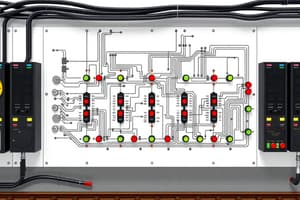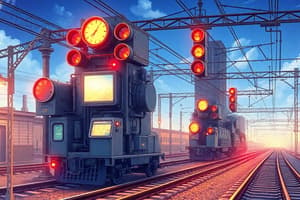Podcast
Questions and Answers
What is the primary purpose of interlocking in railway signalling?
What is the primary purpose of interlocking in railway signalling?
- To control the speed of trains
- To ensure safe routing and movement of trains (correct)
- To improve passenger comfort
- To schedule train maintenance
Who is the article primarily intended for?
Who is the article primarily intended for?
- Passenger safety advocates
- Experienced signal engineers
- IRSE members new to the industry (correct)
- Train operators
How is 'interlocking' defined in the context of railway signalling?
How is 'interlocking' defined in the context of railway signalling?
- A feature that makes the state of two functions mutually dependent (correct)
- A system for scheduling train maintenance
- A technology for improving passenger comfort
- A method for controlling train speed
Where can one expect to find 'interlockings' in a railway signalling system?
Where can one expect to find 'interlockings' in a railway signalling system?
What will be the focus of the next month's article on interlocking?
What will be the focus of the next month's article on interlocking?
'Interlocking' is central to railway signalling because it ensures ___________.
'Interlocking' is central to railway signalling because it ensures ___________.
What is the primary purpose of interlocking in railway signalling?
What is the primary purpose of interlocking in railway signalling?
What does interlocking not do in the context of railway signalling?
What does interlocking not do in the context of railway signalling?
What is the specified 'safety integrity level' (SIL) that modern main line or metro railway signalling systems must usually meet?
What is the specified 'safety integrity level' (SIL) that modern main line or metro railway signalling systems must usually meet?
Which safety principle is traditionally associated with railway signalling, particularly with interlocking?
Which safety principle is traditionally associated with railway signalling, particularly with interlocking?
What must be executed only when it is safe to do so in railway signalling?
What must be executed only when it is safe to do so in railway signalling?
What is one of the primary purposes of interlocking features in railway signalling?
What is one of the primary purposes of interlocking features in railway signalling?
What does interlocking safety ensure in railway signalling?
What does interlocking safety ensure in railway signalling?
Which level of 'safety integrity level' (SIL) is required for interlocking functions in modern main line or metro railway signalling systems?
Which level of 'safety integrity level' (SIL) is required for interlocking functions in modern main line or metro railway signalling systems?
'Fail-safe' property associated with interlocking systems stops trains by ____________.
'Fail-safe' property associated with interlocking systems stops trains by ____________.
What is one of the underlying safety principles traditionally associated with railway signaling, particularly with interlocking?
What is one of the underlying safety principles traditionally associated with railway signaling, particularly with interlocking?
What is the primary focus of the article 'Interlocking Part 1'?
What is the primary focus of the article 'Interlocking Part 1'?
Where might one find 'interlockings' within a railway signalling system?
Where might one find 'interlockings' within a railway signalling system?
How is 'interlocking' defined in the context of railway signalling?
How is 'interlocking' defined in the context of railway signalling?
'Fail-safe' property associated with interlocking systems stops trains by ____________.
'Fail-safe' property associated with interlocking systems stops trains by ____________.
What will be the primary focus of the next month's article on interlocking?
What will be the primary focus of the next month's article on interlocking?
'Interlocking' is central to railway signalling because it ensures ___________.
'Interlocking' is central to railway signalling because it ensures ___________.
What is the fail-safe principle associated with interlocking in railway signalling?
What is the fail-safe principle associated with interlocking in railway signalling?
What is one of the underlying safety principles traditionally associated with railway signaling, particularly with interlocking?
What is one of the underlying safety principles traditionally associated with railway signaling, particularly with interlocking?
What must be executed only when it is safe to do so in railway signalling?
What must be executed only when it is safe to do so in railway signalling?
Which safety integrity level (SIL) is required for interlocking functions in modern main line or metro railway signaling systems?
Which safety integrity level (SIL) is required for interlocking functions in modern main line or metro railway signaling systems?
What does interlocking not do in the context of railway signaling?
What does interlocking not do in the context of railway signaling?
What is the primary purpose of interlocking in railway signaling?
What is the primary purpose of interlocking in railway signaling?
'Fail-safe' property associated with interlocking systems stops trains by ____________.
'Fail-safe' property associated with interlocking systems stops trains by ____________.
'Interlocking' is central to railway signaling because it ensures ___________.
'Interlocking' is central to railway signaling because it ensures ___________.
What is one thing that interlocking safety does not ensure in railway signaling?
What is one thing that interlocking safety does not ensure in railway signaling?
What is one of the primary purposes of these interlocking features in railway signaling?
What is one of the primary purposes of these interlocking features in railway signaling?
Flashcards
Interlocking Purpose
Interlocking Purpose
Prevents conflicting train movements, enhancing safety.
Interlocking Definition
Interlocking Definition
A system preventing simultaneous conflicting route operations using mechanisms and signals.
Interlocking Locations
Interlocking Locations
Control panels, signal boxes, and track circuits.
Interlocking Importance
Interlocking Importance
Signup and view all the flashcards
Modern System Safety Level
Modern System Safety Level
Signup and view all the flashcards
Railway Signalling Safety Principle
Railway Signalling Safety Principle
Signup and view all the flashcards
Railway Signaling Rule
Railway Signaling Rule
Signup and view all the flashcards
Primary Purpose
Primary Purpose
Signup and view all the flashcards
SIL4 Requirement
SIL4 Requirement
Signup and view all the flashcards
Fail-Safe Property
Fail-Safe Property
Signup and view all the flashcards
Underlying Safety Principle
Underlying Safety Principle
Signup and view all the flashcards
Interlocking Definition (recap)
Interlocking Definition (recap)
Signup and view all the flashcards
Fail-safe action
Fail-safe action
Signup and view all the flashcards
Fail-Safe Principle
Fail-Safe Principle
Signup and view all the flashcards
Interlocking Goal
Interlocking Goal
Signup and view all the flashcards
Safe Stop
Safe Stop
Signup and view all the flashcards
Conflicting routes
Conflicting routes
Signup and view all the flashcards
Safe routes
Safe routes
Signup and view all the flashcards
Trains safety
Trains safety
Signup and view all the flashcards
Safe Operation
Safe Operation
Signup and view all the flashcards
Train Movement
Train Movement
Signup and view all the flashcards
Failsafe
Failsafe
Signup and view all the flashcards
Prevents conflict
Prevents conflict
Signup and view all the flashcards
Signalling
Signalling
Signup and view all the flashcards
Safety First
Safety First
Signup and view all the flashcards
Safety Principles
Safety Principles
Signup and view all the flashcards
Always Safe
Always Safe
Signup and view all the flashcards
The System
The System
Signup and view all the flashcards
Safety Systems
Safety Systems
Signup and view all the flashcards
Stopping
Stopping
Signup and view all the flashcards
Study Notes
Interlocking in Railway Signalling
- The primary purpose of interlocking in railway signalling is to ensure safety by preventing conflicting movements of trains.
- Interlocking is defined as a system of interlocking mechanisms and signals that prevents the simultaneous operation of conflicting routes.
- Interlockings can be found in control panels, signal boxes, or even within the track circuit itself.
- The next month's article will focus on the different interlocking types and their functionalities.
- Interlocking is central to railway signalling because it ensures the safe movement of trains by preventing conflicting operations.
- Interlocking does not ensure that trains arrive at their destination on time or that the trains run with optimal efficiency.
- Modern main line or metro railway signalling systems must usually meet the safety integrity level (SIL) 4.
- The safety principle traditionally associated with railway signalling, particularly with interlocking, is the fail-safe principle.
- In railway signalling, only safe operations should be executed.
- One of the primary purposes of interlocking features is to prevent conflicting movements of trains.
- Interlocking safety ensures that only safe movements are executed, and conflicting operations are prevented.
- Interlocking functions in modern main line or metro railway signalling systems require SIL4.
- The fail-safe property associated with interlocking systems stops trains by defaulting to a safe state, typically by stopping the train.
- One of the underlying safety principles associated with railway signalling, particularly with interlocking, is fail-safe operation.
- The article 'Interlocking Part 1' focuses on the basics of interlocking in railway signalling.
- Interlockings can be found within control panels, signal boxes, and track circuits.
- Interlocking is defined as a system of interlocking mechanisms and signals that prevents the simultaneous operation of conflicting routes.
- The fail-safe property associated with interlocking systems stops trains by defaulting to a safe state, typically by stopping the train.
- The next month's article will focus on the different interlocking types and their functionalities.
- Interlocking is central to railway signalling because it ensures the safe movement of trains by preventing conflicting operations.
- The fail-safe principle associated with interlocking in railway signalling ensures trains stop automatically if a fault occurs in the system.
- One of the underlying safety principles traditionally associated with railway signalling, particularly with interlocking, is fail-safe operation.
- In railway signalling, only safe operations should be executed.
- Interlocking functions in modern main line or metro railway signaling systems require SIL4.
- Interlocking does not guarantee that trains arrive at their destination on time or that the trains run with optimal efficiency.
- The primary purpose of interlocking in railway signalling is to ensure safety by preventing conflicting movements of trains.
- The fail-safe property associated with interlocking systems stops trains by defaulting to a safe state, typically by stopping the train.
- Interlocking is central to railway signalling because it ensures the safe movement of trains by preventing conflicting operations.
- Interlocking safety does not ensure that trains arrive at their destination on time or that the trains run with optimal efficiency.
- One of the primary purposes of these interlocking features is to prevent conflicting movements of trains.
Studying That Suits You
Use AI to generate personalized quizzes and flashcards to suit your learning preferences.




